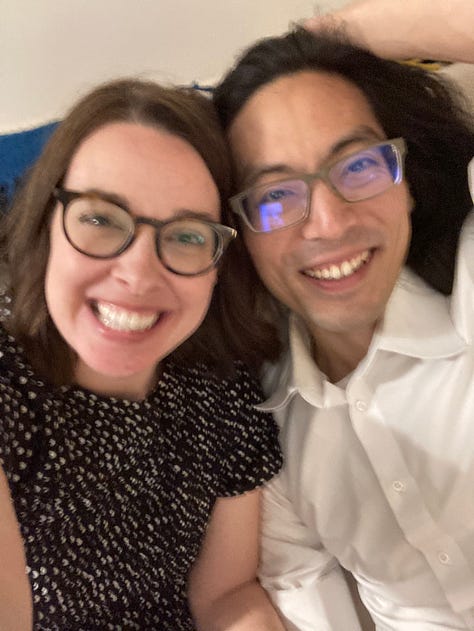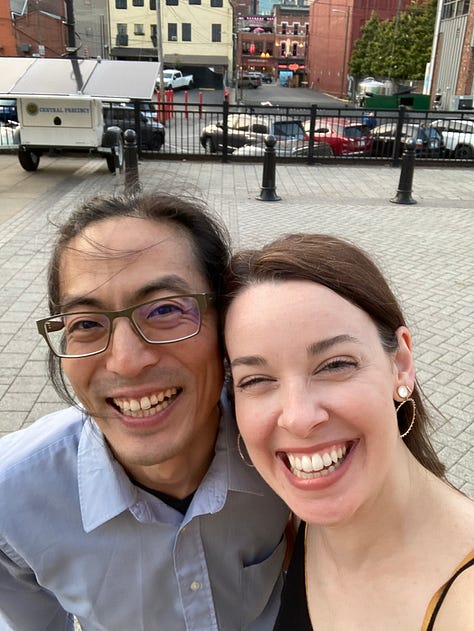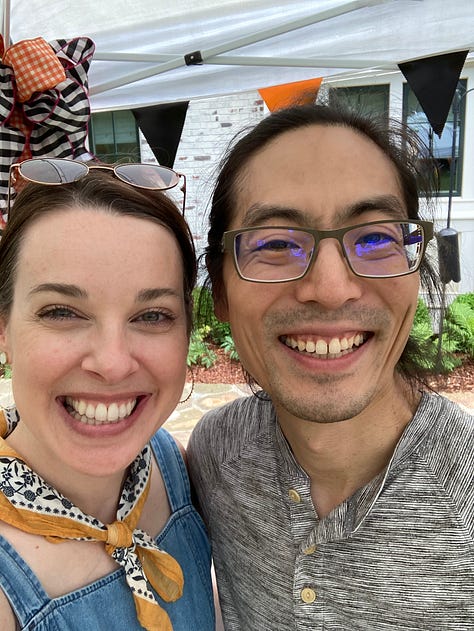Coming June 9—my interview with poet, songwriter and most delightful human of all time, Katy Bowser Hutson. For today, an essay on falling in love.

In the fall of 2023, the art gallery at my church featured the work of contemporary painter Makoto Fujimura. His work is a type of abstract expressionism art, using a traditional Japanese art technique called nihonga. (Nihonga means ‘Japanese’ and the term originated to differentiate Japanese paintings from Western ones.) Mineral pigments are pulverized by hand to become paint. Many paintings hold upwards of 80-100 layers of paint. In between each layer, Fujimura must wait for the paint to dry, aptly titling this art form ‘slow art’. The layers are prismatic, trapping light between each layer as the paint settles. This is the magic of his work. At first glance? There seems to be no surprise. If you linger and look carefully: light, layers, magic.
“I studied him last semester for my Theopoetics class,” I mentioned from the backseat. Kate was driving, Katy was in the passenger seat. We were on our way from Nashville to Grand Rapids, Michigan, for the Festival of Faith and Writing. As women do on road trips, we had been talking for hours. We were somewhere in Indiana when Katy asked me about school.
I reminded them that I was studying Theopoetics and Writing at Bethany Seminary. They both buzzed with delight at the word theopoetics. “Oooooo, tell us everything!”
they sang. Writers especially love this term. Katy is a published author; Kate had packed her manuscript of her first book to take to the festival. I was along for the ride, talking about choosing Makoto Fujimura to study for one of my classes.
“Do you think you chose him, Becca, subconsciously, because of Hitoshi?” Katy asked.
“Hmmmm,” I hummed, looking out the window. Did I?
Hitoshi Yamaguchi.
Tosh—my favorite nickname of his—is, in fact, Japanese. I first met him when I moved to Nashville in 2015, in the living room of my friend Sandra who was hosting a get together for all the musicians who served at the small Anglican parish we attended. Tosh is a vocalist, cellist, bass player; I am a vocalist and piano player. We played music together and found ourselves at game nights and restaurants after church, running in the same circles.
Two years after we met, he asked me on a date. I politely declined. I enjoyed his friendship but could not imagine a deeper connection with him. Tosh is cerebral where I am emotional, steady where I am wild, concrete where I am abstract. I thought these differences were too obvious and opposing to the love I imagined.
The first time I heard of Makoto Fujimura was also through my friend Sandra. His book Culture Care was on her bookshelf, his newest book Art and Faith on her bedside table. Charged with the task of studying a ‘theopoet’, or someone who was engaging with God through their art for my first Theopoetics class, I initially thought I could study someone with whose work I was already more familiar.
Then, one day on my walk through the art gallery at my church, I noticed Fujimura’s work. My part-time work as a worship leader at this church means that at least twice a week, I make the trek from the church offices through the art gallery to our worship space. (This is one of my favorite perks of the job!) The current exhibit featuring the work of Makoto Fujimura had just been installed, titled “My Bright Abyss”, named after Christian Wiman’s poem and book of the same title.
I stopped in front of one piece, “My Bright Abyss #2” because I thought I saw it sparkle. At 48x60 inches, this canvas is covered in blue and green pigments. I imagine if one zoomed in on a satellite picture of Earth, this is what we would find: swirls of blue and green coagulating together. I walk closer. It is sparkling. Then I feel as if I am not on earth but splashing around in water, the speckled and refractive quality of the layers of paint seemingly creating a kind of movement.
What exactly was I seeing? I felt that I was being seen by his art as much as I was doing the seeing. I decided to study Fujimura, spending an hour a week in the gallery with the artwork and reading two of his books. I wrote 9 poems in response to what I felt and experienced while learning to slow down and listen, look and respond to what I was encountering.
After I declined his invitation for a date, Hitoshi and I settled into a comfortable platonic friendship for the next several years. I was grateful he still wanted to be my friend, and a good one at that. He helped me move across town and played cello on my record. We saw one another at church and in mutual circles of friends. My respect for him grew deeper, but my vision was still blurred. I was on and off dating apps, looking for what I thought I needed: loud, gregarious, extroverted. Hitoshi is gentle, inquisitive, present.
On New Years Eve in 2021, I was dog sitting at Sandra’s house (the more I write the more I realize how integral she is to my life and its many lovely threads!) She conveniently lived around the corner from where Hitoshi lived, so he called me up and asked to come by to catch up. We sit outside on her back porch, bundled up. (This was during another COVID-19 spike and were obediently following protocol.) We talk for a few hours until I think my lips turn blue and we part ways. I run inside to warm up and I feel keenly aware of how I look. I usually worry about how I look for dates (will he think I’m beautiful?) but not for Tosh, my friend. Why do I worry about this now?
A few days later, he asks me out again. He knows I have told him no once, but he keeps circling me in his mind and heart, like an orbit. He asks if I am open to considering a date once more? I tell him no again.
I know, I know.
No.
No.
Theopoetics is a conversation starter. At the end of this first year of my program, I am finding there is not one singular definition, which can be delightful and infuriating. Standing outside last fall at a party, a friend asked how I would define it. I thought for a moment and replied, “The study of God without an answer.” I once took an entry level improv class, where the two most important rules are saying, “yes, and”, and theopoetics feels like a kind of improv, too. It’s a conversation—between God and myself. The moment I say, “no” to whatever gift my improv partner has given me—whatever God has given me— the conversation is over.
In July of 2022, I hire Hitoshi to play cello with me at church one Sunday morning. We both were the first ones to rehearsal, and as soon as I saw him, I was struck by this one clear, resounding reality: love.
There is a line in Annie Dillard’s Pilgrim at Tinker Creek that I have never forgotten, and it is how I felt that summer morning: “I had been my whole life a bell, and never knew it until the moment I was lifted and struck.”
Ding…I love him.
Ding… I love him.
Ding…I love him.
Love past, love present.
A revelation? Was it truth or fiction? I had been busy searching for approval, disguised as dating. I was currently on a dating app, and didn’t have any idea how to process these feelings. The layers felt too deep, too complicated now. Were my feelings real? I didn’t want to mess with his heart while I sorted through mine, so I buried it and persisted in online dating. Surely nothing was blooming between us after all this time…
New York Times columnist David Brooks wrote in 2019 that Fujimura’s process driven art is “a small rebellion against time.” Not only is the process by which he creates the paints time consuming, but Brooks reminds us that enjoying the beauty of his work requires our deep and patient attention. Fujimura once told him to stare at one of his painting for 10-12 minutes.
Modernity is defined by chronological time, moving from one hour into the next, racing against the tick-tock-tick-tock meter ever pounding outside of us and within, thump-THUMP-thump-THUMP. Spending 10-12 minutes in front of one painting might feel difficult for most of us. Or entering your mid 30’s and being single when the dream for relationship has seemingly withered away might feel impossibly hopeless.
With God, there seems to be another kind of time in motion, one that isn’t bound by chronology. The Greeks called this kairos, meaning season or appointed time. Fujimura seems well acquainted with kairos time, rebelling against the clock as god, surrendering all that is within and without and trusting it all to be worked into goodness and beauty. God is making Makoto; Makoto is making art. A call and response within time and outside of it.
I persisted in online dating, telling friends I was only looking for a “good man”—and I found one. We dated for almost 6 months and I have only kind and generous comments to make about him. Our parting was heartbreaking, doubled by the realization that I had abandoned myself in search of affirmation and rescue. The year that followed was as crucial as it was painful.
When I think about how pulverized my heart felt then— and worse yet, it felt pulverized by own foolishness— I think about those minerals being crushed to become pigments of color. As hard as I might try to create beauty, I am simply matter in the hands of the artist. (And I matter so very much to God, as do you.) I have surrendered my heart to God over and over and each time, where I expect to find the end, I find the beginning. This time (kairos time?) I finally saw a bit of gold shining in that pulverized mess of my heart—the desire that had been thump-thump-thumping in my heart for a long while—the desire to know Hitoshi Yamaguchi in more than just my friend.
In January of 2024, I confided in a dear girlfriend that I had been thinking of him for the last two years. I had been praying in secret that he would ask me out one last time. I was calling him to go see movies with me and join me at the improv club and get together to help chart songs for church—dating him in one sense without the poor man ever having a clue. When I told my friend of all these complicated layers, she looked at me and said, “You said no. If you want to say yes, you’ve got to tell him.”
Through all these years of longing for partnership and marriage, I thought God was constantly shutting down the conversation with “no.” I realized that I was the one saying no all this time.
As I write this, I’m stretched out on my couch, facing Hitoshi. His right hand is gently stroking my feet and he’s holding the latest edition of The Atlantic in his left hand. Every now and then he peaks out from behind the magazine, smiling at me. I smile back and wiggle my feet.
In February, I asked him to go on a walk where I shared my heart with him. “I know we can’t go back, and I’m not asking us to, but I’m curious… if you’re still open to taking me on that date?” After our third date, he sat on my couch and told me as plain as day: I want you, I want us, and I’m not going anywhere until you tell me otherwise. I leaned my head on his shoulder and the world made sense.
I have been pondering Katy’s question—if I subconsciously chose to study Makoto Fujimura because of my secret love of Hitoshi—and I think it’s possible. I was drawn to Fujimura’s work the same way I am drawn to Hitoshi. He is beautiful and prismatic, and all the many layers of our friendship over the years are the way the light of our love is settling in. The longer I spend with him, the more beauty I see, and I am being seen as much as I am doing the seeing.
I tried apologizing recently to Hitoshi for saying no for all those years, wondering what could have been. “We’re here now,” he says. We sit in a sweet silence, reveling in the us of us. “I wasn’t ready for you then,” he continues…and I knew what he meant.
A Sara Groves song, “Signal” floats to mind—
Many cliches about living this life are true the path is worn but for us its new there's no way to know it without discovery marking our missteps with mercy
Mercy feels like a layer of paint waiting to dry. Atop another layer of sadness. Atop another layer of beauty. Atop another layer of forgiveness. Atop another layer of mercy. Atop another layer, another layer, another layer.
This is how I know that God works in kairos time:
after 9 years, this feels like the perfect season to love Hitoshi with all of my heart.






“I want you, I want us, and I’m not going anywhere until you tell me otherwise. I leaned my head on his shoulder and the world made sense.” What a picture of the staying power of love. I’m so happy for Hitoshi. I’m so happy for you. Beautiful!! ❤️🥰👍🤗
I’m so grateful that you are my granddaughter. I get to see you, hear you, read your poignant words, and share in good times, sad times, happy times …all the time😍. So happy that you and Tosh will be here soon. Love is magic. Right?